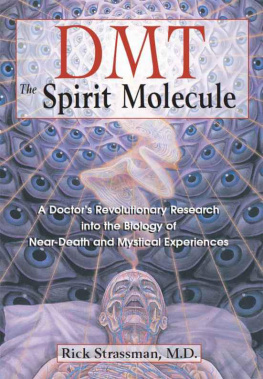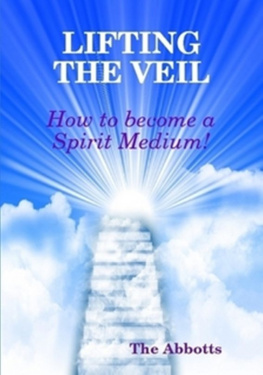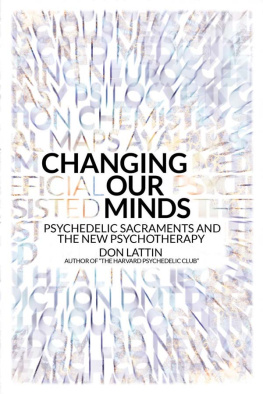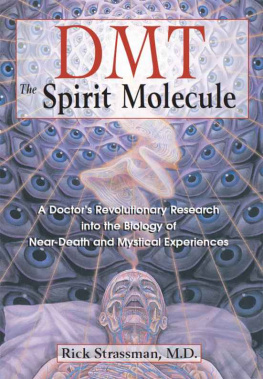
To the volunteers, and all their relations
We do not possess imagination enough to sense what we are missing.
Jean Toomer
Advance Praise for
DMT: The Spirit Molecule
Strassmans important research contributes to a growing awareness that we inhabit a multidimensional universe that is far more complex and interesting than the one our scientific theories have shown us. It is of the utmost importance that we face the implications of this discovery, for it has so much to tell us about who we are and why we are here.
John Mack, author of Abduction and Passport to the Cosmos
The most extensive scientific study of the mental and perceptual effects of a psychedelic drug since the 1960s. Strassman provides fascinating insight into the world of psychiatric research as he seeks to understand these most mysterious substances and their profound effects on human consciousness.
Ralph Metzner, Ph.D., author of Ayahuasca: Consciousness and the Spirits of Nature
This book is essential reading for anyone with an interest in the mind, philosophy, the nature of reality, and spirituality. The worlds foremost expert on DMT has created a masterpiece of the genre, as he brilliantly leads the reader through a series of startling revelations about the nature of the universe, revealed behind the doorway once DMT turns the key.
Karl Jansen, M.D., Ph.D., author of K. Ketamine: Dreams and Realities
DMT: The Spirit Molecule points the way beyond the present impasse of the reigning drug abuse paradigm. We owe a debt of gratitude to Strassman for persevering in the face of bureaucratic obstacles to conduct important research into the human pharmacology of DMT and elucidate it for the general public, in both scientific and humanistic terms.
Jonathan Ott, author of The Age of Entheogens and Hallucinogenic Plants of North America
Acknowledgments
C ountless colleagues, committees, and agencies helped with all stages of this research. Several deserve special mention. The late Daniel X. Freedman, M.D., from UCLAs Department of Psychiatry, advocated for these projects at all levels and was instrumental in my obtaining crucial early funding. Staff at the U.S. Food and Drug Administration and the U.S. Drug Enforcement Administration were extraordinarily flexible and responsive to the unusual circumstances of this research. Clifford Qualls, Ph.D., the University of New Mexico biostatistician, spent endless hours, days, and weeks crunching numbers at the Research Center, at his home, and at mine. David Nichols, Ph.D., from Purdue University, made the DMT, without which the research never would have occurred.
At every turn, the University of New Mexico School of Medicine provided academic, physical, and administrative support for my work. Walter Winslow, M.D., chairman of the Department of Psychiatry, gave me great latitude as one of his only clinical research scientists at the time. Samuel Keith, M.D., continued with outstanding administrative and academic assistance and counsel after Dr. Winslow retired. Alan Frank, M.D., chair of the universitys Human Research Ethics Committee, handled my requests with consistency and evenhandedness.
To the UNM General Clinical Research Center I express my appreciation for their decade of assistance in all my studies: melatonin, DMT, and psilocybin. Jonathan Lisansky, M.D., a UNM Psychiatry and Research Center colleague, originally introduced me to the late Glenn Peake, M.D., Scientific Director of the GCRC. Together they enticed me to Albuquerque in 1984. Philip Eaton, M.D., effortlessly took over the reins of the GCRC after Dr. Peakes sudden death, and barely blinked an eye when I told him I had decided to study psychedelic drugs. David Schade, M.D., Joy McLeod, and Alberta Bland helped with me with skillful laboratory support throughout the years. Lori Sloane of the Computing Center kept all the machines running at top efficiency with what seemed to be amazing ease, and taught me to use programs that otherwise would have taken me years to understand.
Many thanks to the inpatient and outpatient nursing staff, kitchen personnel, and administrative staff, especially Kathy Legoza and Irene Williams. Laura Berg, M.S.N, and Cindy Geist, R.N., provided heroic, cheerful, and disciplined nursing support for all the studies. Katy Brazis, R.N., also contributed her skills to the early psychiatric interviews.
A generous research grant from the Scottish Rite Foundation for Schizophrenia Research helped establish the earliest phases of the DMT projects scientific merit. Later, more substantial funding for the DMT and psilocybin research came from the National Institute on Drug Abuse, a division of the U.S. National Institutes of Health.
For the writing of this book, John Barlow and the Rexx Foundation, as well as Andrew Stone, provided crucial financial kindling, while support from the Barnhart Foundation later set the project blazing forth. Rick Doblin at the Multidisciplinary Association for Psychedelic Studies graciously and generously administered the Stone and Barnhart support. Ned Naumes of the Barnhart Foundation and Sylvia Thiessen and Carla Higdon at MAPS seamlessly coordinated the movement in and out of grant monies.
Friends, colleagues, students, teachers, and mentors over the years have contributed ideas and support to this project: Ralph Abraham, Debra Asis, Alan Badiner, Kay Blacker, Jill and Lewis Carlino, Ram Dass, David Deutsch, Norman Don, Betty Eisner, Dorothy and James Fadiman, Robert Forte, Shefa Gold, Alex Grey, Charles Grob, Stan Grof, John Halpern, Diane Haug, Mark Galanter, Mark Geyer, Chris Gillin, George Greer, Abram Hoffer, Carol and Rodney Houghton, Daniel Hoyer, Oscar Janiger, David Janowsky, Karl Jansen, Sheperd Jenks, Robert Jesse, Robert Kellner, Herbert Kleber, Tad Lepman, Nancy Lethcoe, Paul Lord, David Lorimer, Luis Eduardo Luna, John Mack, Dennis and Terence McKenna, Herbert Meltzer, David Metcalf, Ralph Metzner, Nancy Morrison, Ethan Nadelmann, Ken Nathanson, Steven Nickeson, Oz, Bernd Michael Pohlman, Karl Pribram, Jill Purce, Rupert Sheldrake, Alexander and Ann Shulgin, Daniel Siebert, Wayne Silby, Zachary Solomon, Myron Stolaroff, Juraj and Sonja Styk, Steven Szra, Charles Tart, Requa Tolbert, Tarthang Tulku, Joe Tupin, Eberhard Uhlenhuth, Andrew Weil, Samuel Widmer, and Leo Zeff. My former wife, Marion Cragg, was there for me and the research through all its twists and turns, providing valuable advice and counsel.
Several people additionally read all or part of the manuscript and commented liberally and helpfully on the work-in-progress: Robert Barnhart, Rick Doblin, Rosetta Maranos, Tony Milosz, Norm Smookler, Andrew Stone, Robert Weisz, and Bernard Xolotl.
Many thanks to Daniel Perrine for rendering the best possible images of the books molecular structures. And to Alex Grey, deep appreciation for the cover art, and for leading me to Inner Traditions, where Jon Graham liked what he saw in my proposal. Rowan Jacobsen has been everything an editor can be, and then some. Nancy Ringers peerless copyediting made many improvements to the text.
I am grateful to my former Zen Buddhist communitys late abbot, and to the monastic and extended lay communities for their teaching, guidance, and a powerful model of mystical pragmatism.
My deepest thanks go to my family, for without my parents, Alvin and Charlotte Strassman; my brother, Marc Strassman; and my sister, Hanna Dettman, none of this would have been possible.
Finally, I salute, bow, and stand in awe of the volunteers. Their courage to hitch themselves to the spirit molecules wings, their faith in the research team watching over their bodies and minds while they ventured forth, and their grace under the most austere and unforgiving environment imaginable for taking psychedelic drugs will serve as an inspiration for generations of fellow seekers.
Next page







